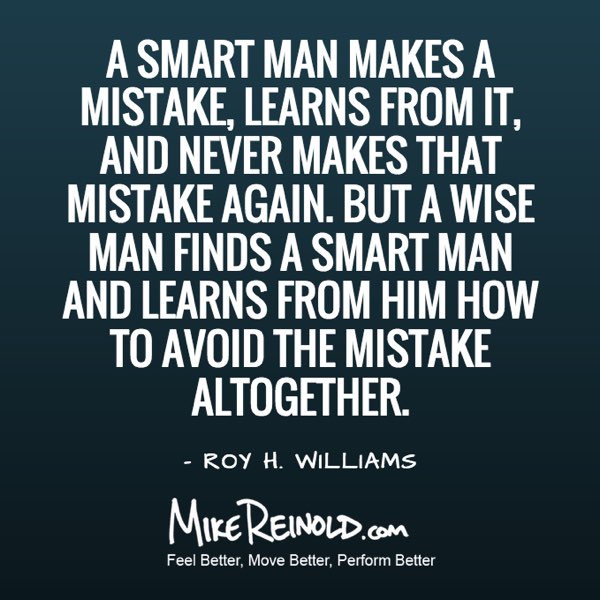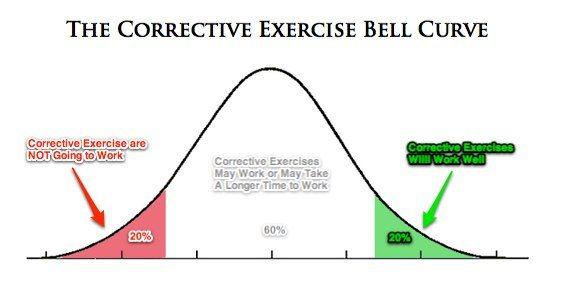
In addition to reflecting on your own personal practice, I think there is also a lot to learn about from your clients when they tell you their past experiences with other professionals.
I tend to see a lot of clients that have tried other health care and fitness professionals and for whatever reason find themselves with me after not achieved the results that they wanted. In my experience, this is often due to a few reasons:
- They didn’t listen
- They didn’t connect
- They didn’t put in the time
Notice how none of these things are “clinical” in nature. Sure, I see my fair share of clients that were not diagnosed well or treated properly, but in all reality, I’m not perfect either. But I listen, connect, and put in the time. This allows my the luxury of being able to call an audible with my clients when I feel we may have started down the wrong path. They trust me. If they didn’t trust me, they’d move on to the next clinician.
How about these two comments I received recently from clients about their past experiences with other professionals.
- “All my therapist did was tell me what I was doing wrong. I know what I am doing wrong, that’s why I went to therapy.”
- “I left my last therapist and always felt bad about myself. They made me feel bad about myself.”
For the young clinicians (and I guess the more experienced one’s too!), I want to share some of the things I have picked up over the years that clients hate. Remember, you need to connect in order to do you best with your clients. Learn from my mistakes and errors and avoid these 6 things you do that your clients hate!
Stare at Your Device
I can’t think of a worse way to start off your experience with a healthcare professional than having them stare at their computer and typing while asking you a series of questions. Not a great way to connect and help your client feel like your are compassionate about them, rather than just trying to finish your “task” of their evaluation. I still take notes briefly when pencil and paper and do my documentation afterwards. Sure, it takes more time out of my day, but it’s the right thing to do.
This also goes for staring at your phone their whole session. You could be responding to a highly urgent and work-related email, but realize your clients will just assume your are posting pics of your kittens on Facebook. Excuse yourself and respond to an urgent message if you must, but don’t do it right in front of your client. This looks like they are not important to you at the moment. Otherwise, keep your phone in your pocket.
I’m not sure if the Apple Watch is going to help us here or hurt us, we’ll see!
Your client needs to feel like they are the most important person in the world to you during their session.
Don’t Listen to Them
Your first interaction with someone is really important for several reasons. Obviously you need to determine where to start with your client, but it’s also the most critical interaction to development a connection.
This starts with letting them talk. You want to hear their story. Some will want to get right to the point, while others will want to elaborate. Let this happen. Don’t interrupt if you can, and let them lead the discussion.
As I get more experience, the subjective portion of my exam could really only last 30 seconds for me to have enough information to start looking at the client. However, I have learned that a big part of connecting with your clients is listening to your client. You need to provide the platform for them to share what they want with you.
Force Feed What You Want Instead of What They Want
It’s not about you. Starting with this simple concept is a great start.
As an example, perhaps a client comes to you and says “kinesiology tape really makes me feel better.” How do you think they’ll respond when you say, “Your shoulder pain is coming from signals in your brain, kinesiology tape won’t help that and doesn’t really do anything.” Ummm, probably poorly.
You said that kinesiology tape “doesn’t do anything” and they said it “really helps.” That sounds like conflict, not connecting, to me.
In all honesty, we don’t know as much as we think we do about the human body. I have no problem providing a treatment, such as kinesiology tape, if there will be no harm, no long term consequence, and there is no definitive research saying it is ineffective. Obviously, if scientific evidence is available to completely say something is ineffective that changes the topic.
Don’t get me wrong, I will do what I want to do with that client, but may also try some kinesiology tape as well. Perhaps that makes my treatments even more effective.
Another great example in the fitness world is the focus on movement and corrective exercises. I think this is great, but don’t lose focus. If someone comes to you for fat loss and all you talk about is how poor they move and how you want to fix their asymmetrical 1 on the FMS straight leg raise, you are forcing what you want on the client, and not focusing on what they want. They don’t give care at all about what their straight leg raise looks like.
Again, I think you should work on that movement pattern. But that can’t be the focus of the program. It has to meet their goals first. Sure, we sneak our goals into our programs too, but be careful here.
Tell Them Everything That is Wrong with Them and Nothing That is Right
I think we all get carried away sometimes with finding “deficits” during our assessments and evaluations. That is normal. But we need to be careful with how we present this to our clients.
Some people will focus too much on the little things, while others will seem just feel bad about themselves.
Every client should leave your facility feeling better, more optimistic, and in a good mood. You want to be one of the best parts of your clients’ days.
I’ve actually talked about this in the past in an article on The Dale Carnegie Approach to Assessments.
Talk Over Their Head
As you can see, communication and people skills are pretty valuable in our professions. Another area that I often see as being an issues is not bringing the discussion to your client’s level.
Just like you should be trying to match your clients’ energy levels, I also try to bring my discussion to their level as well.
Students and young clinicians are often guilty of this for a few of reasons:
- They are used to talked scientifically to justify what they are doing to their professors
- They haven’t accumulated that database of analogies we all use on our heads
- Unfortunately, they are a little too egotistical and trying to impress the person with how much they know
Confusing someone and talking over their head is not going to impress someone. Some people like to hear all the detailed scientific things, while others just shut you out. You need to feel this out and adjust. However, your ability to convey your points and messages in a manner that connects with each person will impress them.
I use several different tools to accomplish this based on how I feel the conversation is going, but my go-to methods are:
- Using pictures and videos during my evaluation
- Using analogies to compare a complicated point to one they understand. Car analogies work well! Things like, “it’s like driving with your wheels out of alignment, eventually your tires are going to wear down unevenly.”
- Using a whiteboard to express thoughts. This doesn’t always just mean drawing a picture. I also often write and make lists. Some people are more visual learners. You can usually tell when they whip out their phone to take a pic of the whiteboard when you are done!
They key is to give them the science but don’t stop there, back it up with something they can understand.
Criticize Their Other Healthcare Professionals and Past Experience
I’m surprised at how common this point is in our professions. I have many clients that have commented on how other professionals they have worked with in the past just criticize everyone else they have and had worked with in the past. Like a personal training putting down their physical therapist or their physical therapist putting down their chiropractor, as a couple of examples. Realize that your client has probably built up a lot of trust and respect over the years for the other people they are working with, which have not currently built up.
Not only does this make the person feel bad about their past choices (see above), but it’s also very transparent that you are just slamming someone else to try to make yourself look good.
I have a general rule of thumb that I developed over the years after seeing many “prestigious” people commit this error – Don’t make others look bad to make yourself look better. It may work in the short term, but always catches up to you.
Yes, you are a genius when you have the power of hindsight. Everything is clearer in retrospect. Be respectful of their other people your client is seeing and has seen, you aren’t always right.
In reality, I probably could have listed another dozen, but these are a great start. Avoid these 6 things that you do that your clients hate and focus on connecting, listening, and putting in the time to maximize your own effectiveness in helping people achieve their goals.





